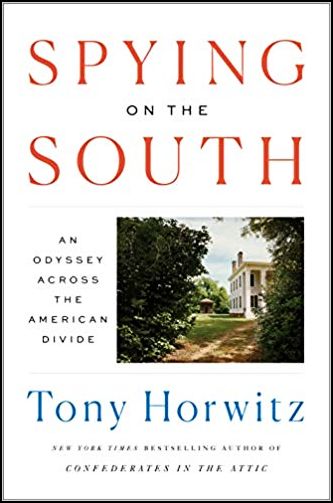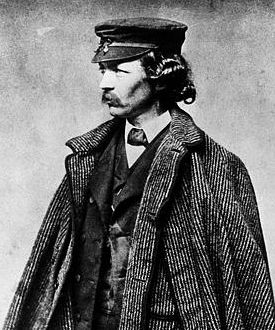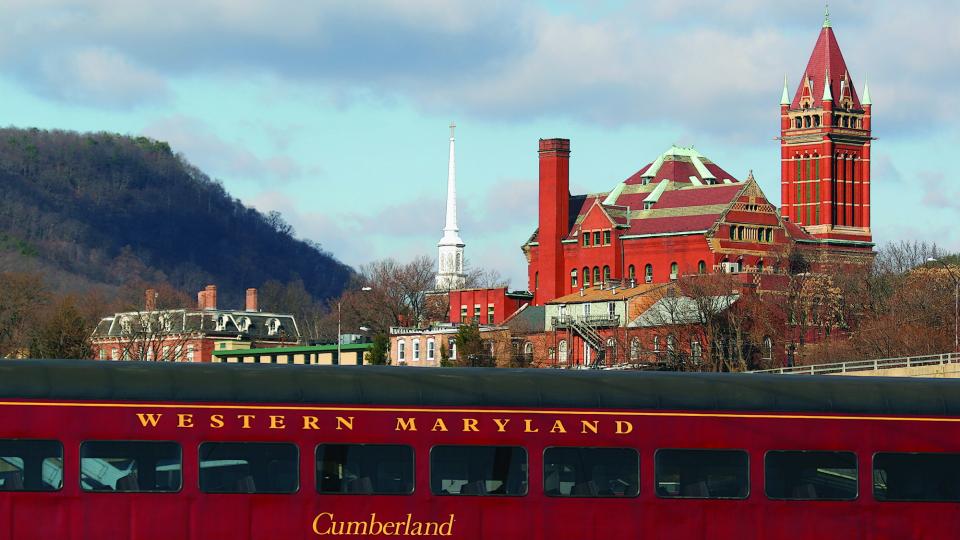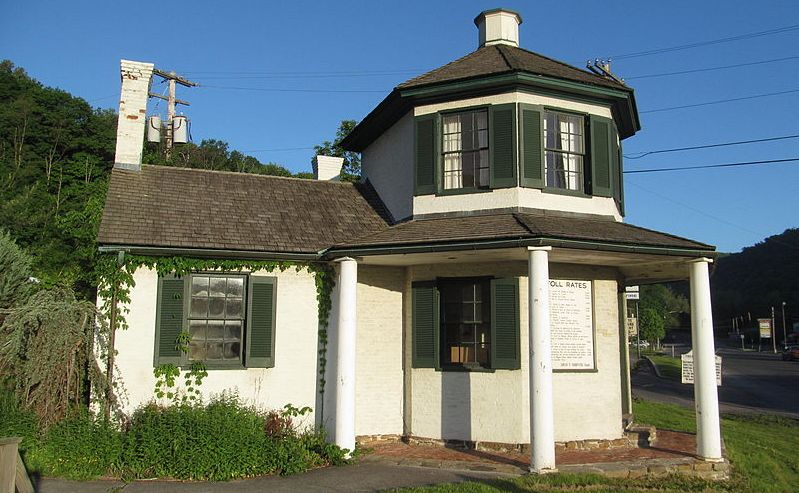The late Tony Horwitz, in his own epic journey, followed in the footsteps of Frederick Law Olmsted, who traveled through the South just before the Civil War to learn about our nation in divided times. Here are some of his observations from West Virginia.
-
October 2020
Volume65Issue6

Editor's Note: Last year I spoke at some length with Tony Horwitz about adapting an essay from his latest book, Spying on the South, for American Heritage. Tragically, shortly afterward, He passed away unexpectedly before we could work together.
We've gone ahead with the project anyway, in tribute to Tony, a favorite author of ours who wrote such national bestsellers as Confederates in the Attic, Baghdad Without a Map, Blue Latitudes, A Voyage Long and Strange, and Midnight Rising.
A native of Washington, D.C., Tony graduated from Brown University and the Columbia Graduate School of Journalism, then covered wars and conflicts around for the world for The Wall Street Journal. He returned to the U.S., won a Pulitzer Prize for national reporting, and wrote for The New Yorker, before becoming a full-time author.
To write Spying on the South, Tony set out in the footsteps of Frederick Law Olmsted who, as a young, restless writer in the 1850s, journeyed across the Southern states as an undercover correspondent for the New York Times.
Olmsted traveled 14 months by horseback, steamboat, and stagecoach, seeking dialogue and common ground. His vivid dispatches about the lives and beliefs of Southerners — white and black, free and enslaved, rich and poor — were a revelation for readers of his day and have endured as classic texts for the study of America on the brink of cataclysmic break-up. Olmsted, of course, later designed of New York's Central Park and so many other public spaces.
Amid the discord and polarization of our own time, Tony asks, Is America still one country? In search of answers, and his own adventures, Horwitz followed Olmsted’s tracks and, often, his mode of transport: through Appalachia, down the Ohio and Mississippi Rivers, into bayou Louisiana, and across Texas to the contested Mexican borderland.

Here are some of Tony's observations about West Virginia. It's absolutely heartbreaking to think this will be the last book from such a beloved author.
--Edwin S. Grosvenor
By Tony Horwitz
“Scene, the South; bound West. It could be nowhere else.”
With this theatrical flourish, Olmsted raised the curtain on his journey to Texas, while aboard a train in Maryland. He also recorded the “dramatis personae” of his rail trip, including a “Virginia gentleman” who expertly spat tobacco through a hinged window, a “black mamma” nursing a white child, and “buxom, saucy, slipshod girls” at rail-side inns, “bursting with fat and fun from their dresses.”

I looked up from my dog-eared travelogue at the coach car on Amtrak’s Capitol Limited. Men in suits staring into laptops. A lean spandexed woman reading a yoga magazine. Two boys murdering aliens on their phones. Out the grimy train window, no sign as yet of the “fine farming country” Olmsted described in Maryland. Just endless suburbs: tract housing, graffiti-covered overpasses, a mattress outlet. It could be anywhere else.
Olmsted rode the B&O Railroad, short for “Baltimore and Ohio,” a passenger line that no longer existed except on Monopoly boards. The closest I could come to retracing his rail path was aboard the Capitol Limited, Amtrak’s daily service between Washington, D.C., and Chicago. The train followed part of the old B&0 route and stopped at Cumberland, the western Maryland town where Olmsted spent his first night.
I planned to do the same. Beyond that I had no plan, other than to follow Olmsted’s path by whatever transport I could. Parallel journeys, 160 years apart: what he saw then and what I’d see now. No bookings. No itinerary. Just a ramble across America with long-dead Fred as my guide.
This had all seemed thrilling and plausible earlier in the day as I’d perused Olmsted’s microfilmed letters in a hushed room at the Library of Congress. “When we were travelling,” Olmsted wrote Charles Brace, reflecting on their tramp around Europe, “we were living a great deal more, getting a great deal more out of the world, loving oftener, hating oftener, reaching a great many more mile stones.”
Now, two hours after leaving the library, I sat next to a snoring commuter as the train crawled through the autumn dusk past malls and subdivisions. Rereading the start of Olmsted’s book, I identified with the nervous “restlessness” and “vague anticipations” he felt at the start of an open-ended journey.
In his day, rail passengers carried their own provisions or dined at rail-side inns. I went to the café car, bought a microwaved Italian club sandwich, and settled at a table, trying to conjure the “new and wilder beauties” Olmsted saw along the upper Potomac. In the early dark, all I could see in the window was my own reflection.
But our rail journeys aligned in one respect. The Capitol Limited kept slowing, due to curves along the Potomac and track the train shared with freight traffic. As a result, a conductor told me, our average speed was about forty miles an hour—not much swifter than Olmsted’s pace in 1853, aboard a steam-engine train.
Arriving in Cumberland on a rainy November evening, Olmsted described it as “a most comfortless place” with “a certain dinginess” that reminded him of mill towns he’d seen in England. Like the nineteenth-century British Midlands, Cumberland and its hilly surrounds were rich in industrial resources: coal, timber, iron ore, water power. The town was also a major transport hub, at the junction of the B&O, the Chesapeake and Ohio Canal, and a pioneering turnpike called the National Road.

“Cumberland is destined to become one of the largest inland towns of America,” Horace Greeley assured readers of the New-York Tribune four years before Olmsted arrived. Local boosters later billed their boomtown the “Gateway to the West.”
In the chill autumn air, I stepped from the Capitol Limited onto a small walkway beside the tracks that led past an American Legion and Veterans of Foreign Wars post, a memorial to a native son killed in Iraq, and a homeless shelter with a sign reading, “Doorway to Hope at the Gateway to the West.”
At the end of the block rose an imposing but run-down Victorian edifice that housed 2nd Chance Bail Bonds and a corner bar. At 8:00 p.m., the only person in the tavern was the owner, Jim McKenzie. I was his second customer of the night.
“We’re a neighborhood bar in a neighborhood that’s about gone,” he said, serving me a bottle of Miller.
The bar was part of the formerly grand Brunswick Hotel, which had served travelers arriving on the twenty passenger trains that once came through Cumberland daily. Factory laborers also packed the bar, which used to stay open from 8:00 a.m. to 2:00 a.m. to accommodate shift workers.
But since its peak during World War II, Cumberland had lost half its population and almost all its industry, including a textile plant where McKenzie had been one of ten thousand employees. The massive plant was torn down in the 1990s to make way for a state penitentiary.
“Locking people up, that’s our industry now,” he said, listing eight correctional facilities that had sprung up in and around Cumberland.
On St. Patrick’s Day, McKenzie cooked pots of cabbage and corned beef and served it free to the homeless at the nearby shelter. “That used to be a place for people down on their luck for a few days,” he said. “Now a lot are long term.”
McKenzie apologized that he couldn’t offer me a bed, since the three-story, fifty-seven-room Brunswick was no longer a functioning hotel. A sixty-eight-year-old widower, he was the only lodger. “Grew up by the railroad and just don’t feel right if I can’t hear trains passing in the night,” he said.
Only freight traffic did so now Apart from the Capitol Limited, and a short scenic ride on a restored locomotive, Cumberland no longer had passenger service. But one major artery from the town’s transport heyday survived: the National Road, which had linked Cumberland to Wheeling, the end point of Olmsted’s ride on the B&O.
So after bedding down at a Ramada by the tracks, I rented a car in the morning at Cumberland’s small airport. The rental agent told me that most of his customers came here to see incarcerated family or residents of Cumberland’s many rehab and methadone clinics. “Prisons, drugs, and gangs,” he said. “It’s beautiful.”
I steered onto Alt US 40, the inelegant modern designation for the National Road as it runs west from Cumberland. The two-lane highway climbed through a mountain cleft that Olmsted described as “a wooded gorge, into which a road enters as into monstrous jaws.”
Sandwiched between tractor trailers, my view of the Narrows wasn’t as dramatic. But my spirits lifted with the altitude. Freed from Cumberland and its prisons, I was headed over the mountains on a historic route trod by thousands of wagons and westward pioneers.

I also spotted a picturesque survival from that era on a busy commercial strip in LaVale, a small town just beyond the Narrows. It was a seven-sided brick structure with a wooden cupola: the National Road’s first tollhouse, dating to the 1830s. A sign listed “Rates of Toll” for an array of old-world vehicles, including sleighs, chariots, and “Phaeton or Chaise With two Horses or 4 Wheels.”
Another marker said the word “Pikers” derived from travelers who tried to avoid paying turnpike tolls by skirting gatehouses like these. Hence the building’s nearly octagonal shape; from its many upstairs windows, toll keepers could keep an eye out for some distance in every direction.
Of his train journey through the mountains beyond Cumberland, Olmsted wrote, “The rails plunge into the wild” and “only by dint of the most admirable persistence in tunneling, jumping, squeezing, and winding, do they succeed in forming a path for the locomotive.”
He had entered the Alleghenies, a rugged part of the Appalachian Mountains. Leaving the National Road to retrace the bygone B&O route, I drove hilly roads trafficked by farm vehicles and logging trucks until a sign welcomed me to “Wild and Wonderful” West Virginia.
The wooded scenery didn’t change, apart from a sudden proliferation of roadside signs declaring, “Stop the War on Coal!” Meanwhile, on the car radio, a Christian program warned of “America’s coming implosion” due to abortion, the removal of prayer from public schools, and an influx of “pagan Muslims” and others “who don’t share our culture.”
The End Times seemed already to have arrived at the first settlement I reached. Old maps identified Terra Alta as a B&O stop in Olmsted’s day, but all I found was a row of abandoned storefronts by the railroad tracks. The only open business was Cheap-0 Depot, a variety shop with lawn and car ornaments decorated with the words “I’m a Proud Coal Miner.”
I asked the proprietor, a middle-aged woman, if there was much coal mining here. “Used to be,” she said.
“Do trains stop at Terra Alta?”
“Used to.” She remembered her father boarding a train when he was drafted during the Vietnam War. “Then they tore the station down.”
“What do people here do now?” I asked.
“Nothing.” Seeing me to the door, she shut off the lights.

